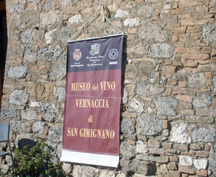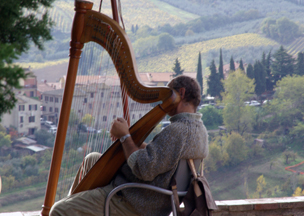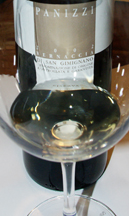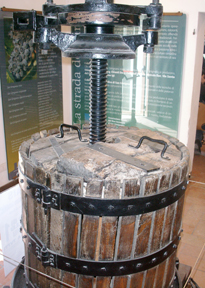Museo del Vino Vernaccia di San Gimignano
by
Terry Sullivan
 Wine museums come in all sizes. Large museums such as Vinopolis, in London, and COPIA, in Napa, offer visitors hours of learning opportunities. However, there are smaller wine museums scattered throughout the world. One such museum lies off the beaten track of the walled city of San Gimignano in Italy.
Wine museums come in all sizes. Large museums such as Vinopolis, in London, and COPIA, in Napa, offer visitors hours of learning opportunities. However, there are smaller wine museums scattered throughout the world. One such museum lies off the beaten track of the walled city of San Gimignano in Italy.
San Gimignano is a medieval city surrounded by rolling Tuscan hills. Vineyards and olive groves cover the countryside. Although there are many Sangiovese grapes grown on these hills, a white grape called Vernaccia has been growing on these hills at least from the thirteenth century.
 Within San Gimignano, tourists amble along the main streets making way for the occasional car. Those adventurous travelers wander off the thoroughfare to explore the quiet side streets that lead to quieter less crowded sites. On a mostly cloudy October Sunday we wandered the side streets trying to catch a stray, warming ray of sunlight. Leaving the murmur of tourists behind, we were drawn to the sound of a harp coming from the Villa della Rocca di Montestaffoli at the top of the town’s hill. A large terrace overlooking the countryside below the city provided a beautiful setting for a harpist hoping to collect coins from passersby.
Within San Gimignano, tourists amble along the main streets making way for the occasional car. Those adventurous travelers wander off the thoroughfare to explore the quiet side streets that lead to quieter less crowded sites. On a mostly cloudy October Sunday we wandered the side streets trying to catch a stray, warming ray of sunlight. Leaving the murmur of tourists behind, we were drawn to the sound of a harp coming from the Villa della Rocca di Montestaffoli at the top of the town’s hill. A large terrace overlooking the countryside below the city provided a beautiful setting for a harpist hoping to collect coins from passersby.
On the opposite side of the terrace, we discovered perhaps one of the smallest wine museums in the world, Museo del Vino Vernaccia di San Gimignano. The museum consisted of several small rooms of artifacts and displays. An attached enoteca provided visitors the opportunity to taste wines made from Vernaccia grapes. The entire museum is devoted to portraying the production of just one wine from one place, Vernaccia from San Gimignano. Visitors learn about the history of this grape and the production methods. The displays are in Italian but photos provide everyone with a good understanding. The museum is free, however; you have to pay for the tastings in the enoteca.

 One can tour the museum in minutes. Centered in one room is an old wine press with displays adorning the walls. Visitors discover that throughout history, Vernaccia was a favorite of popes and the Medici family. Although attempts were made to grow Vernaccia vines in other locations, the grapes produced never created a wine as good as the Vernaccia surrounding San Gimignano.
One can tour the museum in minutes. Centered in one room is an old wine press with displays adorning the walls. Visitors discover that throughout history, Vernaccia was a favorite of popes and the Medici family. Although attempts were made to grow Vernaccia vines in other locations, the grapes produced never created a wine as good as the Vernaccia surrounding San Gimignano.
Wine produced from Vernaccia grapes is a light yellow color and has a fruit nose. It has a fruit taste and is dry with a crisp finish. The wineries near San Gimignano make several types of Vernaccia. Some are aged in stainless steel tanks while others are aged in wood. There are dry Vernaccias and semi-sweet Vernaccias. When tasting in tasting rooms and enotecas, you'll have an opportunity to taste several different Vernaccias.
